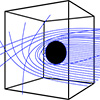 Based on radio telescope data and models of black hole physics, scientists used neural networks to reconstruct a 3D image that shows how explosive flare-ups in the disk of gas around our supermassive black hole might look.
Based on radio telescope data and models of black hole physics, scientists used neural networks to reconstruct a 3D image that shows how explosive flare-ups in the disk of gas around our supermassive black hole might look.
Apr 22nd, 2024
Read more
 Astronomers have produced the first high-resolution map of a massive explosion in a nearby galaxy, providing important clues on how the space between galaxies is polluted with chemical elements.
Astronomers have produced the first high-resolution map of a massive explosion in a nearby galaxy, providing important clues on how the space between galaxies is polluted with chemical elements.
Apr 22nd, 2024
Read more
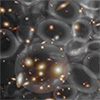 New method uses density reconstruction for joint analysis of two-point functions to extract primary information from three- and four-point functions.
New method uses density reconstruction for joint analysis of two-point functions to extract primary information from three- and four-point functions.
Apr 19th, 2024
Read more
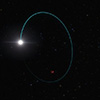 Astronomers have identified the most massive stellar black hole yet discovered in the Milky Way galaxy, with a mass measuring an impressive 33 times that of the Sun.
Astronomers have identified the most massive stellar black hole yet discovered in the Milky Way galaxy, with a mass measuring an impressive 33 times that of the Sun.
Apr 16th, 2024
Read more
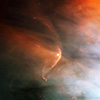 Astrophysicists were able to quantify the mass loss of stars via their stellar winds.
Astrophysicists were able to quantify the mass loss of stars via their stellar winds.
Apr 12th, 2024
Read more
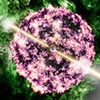 Scientists confirmed that the phenomenon responsible for the historic burst - dubbed the B.O.A.T. ('brightest of all time') - is the collapse and subsequent explosion of a massive star.
Scientists confirmed that the phenomenon responsible for the historic burst - dubbed the B.O.A.T. ('brightest of all time') - is the collapse and subsequent explosion of a massive star.
Apr 12th, 2024
Read more
 Captured by cutting-edge radio telescope technology, a chance reactivation of a magnetar - the Universe's most powerful magnets - has revealed an unexpectedly complex environment.
Captured by cutting-edge radio telescope technology, a chance reactivation of a magnetar - the Universe's most powerful magnets - has revealed an unexpectedly complex environment.
Apr 8th, 2024
Read more
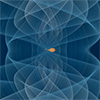 GW230529 gravitational waves hint at neutron star and mystery mass-gap object collision, challenging cosmic understanding.
GW230529 gravitational waves hint at neutron star and mystery mass-gap object collision, challenging cosmic understanding.
Apr 6th, 2024
Read more
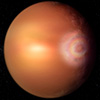 CHEOPS telescope unveils WASP-76b's light asymmetry due to potential 'glory' phenomenon, hinting at uniform clouds reflecting starlight.
CHEOPS telescope unveils WASP-76b's light asymmetry due to potential 'glory' phenomenon, hinting at uniform clouds reflecting starlight.
Apr 5th, 2024
Read more
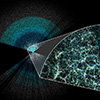 Researchers have used the Dark Energy Spectroscopic Instrument to make the largest 3D map of our universe and world-leading measurements of dark energy, the mysterious cause of its accelerating expansion.
Researchers have used the Dark Energy Spectroscopic Instrument to make the largest 3D map of our universe and world-leading measurements of dark energy, the mysterious cause of its accelerating expansion.
Apr 5th, 2024
Read more
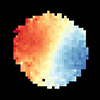 Researchers report that age is the driving force in changing how stars move within galaxies.
Researchers report that age is the driving force in changing how stars move within galaxies.
Apr 3rd, 2024
Read more
 Scientists discovered a rare dust particle trapped in an ancient extra-terrestrial meteorite that was formed by a star other than our sun.
Scientists discovered a rare dust particle trapped in an ancient extra-terrestrial meteorite that was formed by a star other than our sun.
Mar 28th, 2024
Read more
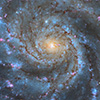 Scientists map out data from a once-in-a-lifetime explosion.
Scientists map out data from a once-in-a-lifetime explosion.
Mar 28th, 2024
Read more
 Physicists are proposing a new way to look for dark matter using quantum devices, which might be naturally tuned to detect what researchers call thermalized dark matter.
Physicists are proposing a new way to look for dark matter using quantum devices, which might be naturally tuned to detect what researchers call thermalized dark matter.
Mar 28th, 2024
Read more
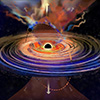 Analysis reveals a tiny black hole repeatedly punching through a larger black hole's disk of gas.
Analysis reveals a tiny black hole repeatedly punching through a larger black hole's disk of gas.
Mar 27th, 2024
Read more
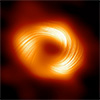 A new image from the Event Horizon Telescope has uncovered strong and organized magnetic fields spiraling from the edge of the supermassive black hole at the center of the Milky Way.
A new image from the Event Horizon Telescope has uncovered strong and organized magnetic fields spiraling from the edge of the supermassive black hole at the center of the Milky Way.
Mar 27th, 2024
Read more
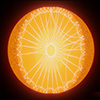 An orange dwarf star has yielded the tiniest 'starquakes' ever recorded, measured by an international team of scientists.
An orange dwarf star has yielded the tiniest 'starquakes' ever recorded, measured by an international team of scientists.
Mar 26th, 2024
Read more
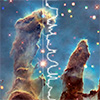 Transforming space visuals into sounds enhances accessibility and engagement with the universe, broadening experiences for visually impaired individuals.
Transforming space visuals into sounds enhances accessibility and engagement with the universe, broadening experiences for visually impaired individuals.
Mar 25th, 2024
Read more
 Based on radio telescope data and models of black hole physics, scientists used neural networks to reconstruct a 3D image that shows how explosive flare-ups in the disk of gas around our supermassive black hole might look.
Based on radio telescope data and models of black hole physics, scientists used neural networks to reconstruct a 3D image that shows how explosive flare-ups in the disk of gas around our supermassive black hole might look.
 Subscribe to our Space Exploration News feed
Subscribe to our Space Exploration News feed















